Author: First Class Cabin
Investment Summary[1]
Merit Circle (MC) is a decentralized DAO chain game guild built on Ethereum and BSC. Initially, Merit Circle was a scholarship guild similar to YGG, with scholarship business[2], SubDao model[3], etc. However, considering the sustainability and limitations of the scholarship business, and the fact that these businesses are almost all suppressed by YGG, it began to transform the structure and positioning of the DAO in March 2022, hoping to build it into a game DAO. Merit Circle divides the DAO into multiple sections (vertical fields). Currently, its main sections are investment, studio (building and incubating new projects), games (chain game market distribution platform), and infrastructure (Beam game chain built on Avalanche, which went live on the mainnet on August 18 this year). In addition, the game NFT platform Sphere, which is still in the development stage, was once one of the four main sections, but due to market factors, its release was postponed, and it was replaced by the infrastructure section.
Merit Circle, formerly known as Axie 420, was a "scholarship" organization for Axie Infinity, founded in July 2021. The initial purpose was to allow players in low-wage countries to play Axie Infinity. In August 2021, Axie 420 received a $200,000 incubation investment from Flow Ventures and raised $1.25 million through other channels. In September 2021, it was renamed Merit Circle, expanding its focus from just Axie Infinity to more popular games and the metaverse.
The advantages of Merit Circle are:
1) The treasury funds are abundant and the information disclosure is transparent, with relatively reasonable fund allocation (according to official treasury data as of June 23 this year: cash accounts for 40%; high liquidity blue-chip tokens account for 8%; NFT assets account for 4%; tokens/equity related to the chain game track account for 48%, with a majority of primary market equity, and the investment targets are mostly traditional game studios combined with blockchain technology, with an overall game style leaning towards playability). The treasury funds amount to approximately $94.1 million, excluding $MC from the treasury calculation, and the treasury funds have decreased by about 7% compared to the end of 2021. In the bear market, Merit Circle ensures sufficient cash flow through reasonable treasury allocation, theoretically possessing the ability to cope with the bear market in terms of funds.
2) Compared with traditional chain game guilds, Merit Circle has taken a significantly different development path. Merit Circle has abandoned the scholarship model and gradually expanded into the mid-to-high end of the chain game industry through investing in the primary market of chain games, collaborating to develop games, building game market distribution platform, and constructing infrastructure.
The risks of Merit Circle are:
1) From an investment perspective, most of the objects invested in by Merit Circle are in the primary market of chain games, accounting for about 80% of the investment in tokens/equity related to the chain game track. Merit Circle's income sources are relatively single, mainly relying on the investment section. Most of the gamefi investments made by Merit Circle are small games, and the market value of the investment part has a large speculative component. The survival rate of such chain games in a bear market is relatively low, with high risks and uncertainties. The short-to-medium-term income situation of Merit Circle is difficult to improve due to market conditions, and the subsequent situation depends on the development of the chain game track and whether the invested games can have a good return, as well as whether the constructed Beam game chain and the upcoming game NFT market Sphere can have good development.
2) The market value of $MC is strongly correlated with the market value of managed treasury assets, and the expected ceiling seems relatively limited for the time being.
3) Due to the lack of attractive gold-making business and community activities, the community foundation of Merit Circle is relatively weak.
1. Basic Overview
1.1 Project Introduction
Merit Circle (MC) is a decentralized DAO chain game guild built on Ethereum and BSC. Its main sections are investment, studio (building and incubating new projects), games, and infrastructure (Beam game chain built on Avalanche, which went live on August 18 this year). In addition, Merit Circle has launched its own NFT collection Edenhorde, and the game NFT platform Sphere is still in the development stage.
1.2 Basic Information[4]
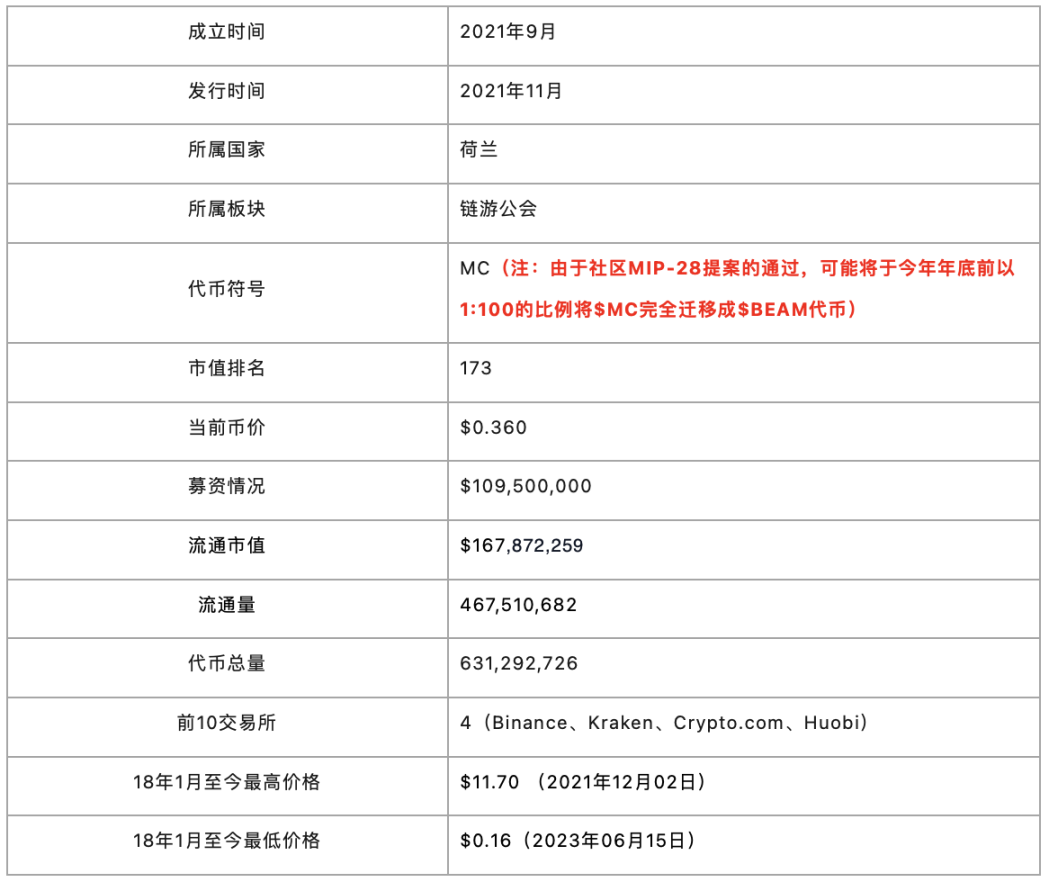
2. Project Details
2.1 Team[5]
According to LinkedIn data, the Merit Circle team consists of 33 members. From the team's background, team members generally have a background in blockchain work, and core members have been deeply involved in Axie Infinity and have a background in web3 investment institutions.

Marco van denHeuvel——Co-founder, graduated from the Arnhem Business School with a major in International Business and Languages in 2019. From September 2017 to October 2018, he co-founded a blockchain company called Happy Mod, focusing on providing community management and marketing services for blockchain startups; founded Axie 420 "scholarship" organization in July 2021, renamed Merit Circle in September 2021.

Tommy Quite——Co-founder, graduated from Beijing University of Technology with a major in Contemporary Chinese Business and Language, and from Utrecht University of Applied Sciences with a major in Entrepreneurship and Small Business Operations. From April 2014 to September 2018, he was a member of the Bitcoin Foundation[6], dedicated to advocating and promoting Bitcoin and blockchain technology; from July 2017 to August 2019, he worked at Civic, a web3 identity management tool provider, as a community manager; co-founded Flow Ventures, a web3 venture capital firm, in December 2020; co-founded Merit Circle in August 2021.

Mark Borsten——Co-founder[7] (Twitter @meritcirclorr, personal information not publicly available on LinkedIn), Chief Operating Officer and co-founder of Flow Ventures, joined Merit Circle with Tommy Quite.

Thale Sonnemans——COO, graduated from San Francisco State University with a major in Marketing Management and Hanze University of Applied Sciences with a major in Business Administration. From July 2012 to July 2013 and January 2016 to December 2018, he held positions as a junior producer and junior sales representative at HALAL (a film production company and photography agency); from April 2019 to October 2021, he co-founded a gambling affiliate company called Chaser; joined Merit Circle in August 2021.

Brandon Aaskov——CTO, graduated from the New England Institute of Art with a major in Interactive Media Design. From February 2006 to March 2013, he worked at Brightcove, a streaming media technology company, as a senior solutions engineer; from June 2015 to February 2023, he worked at DEPT®, a software product agency, holding positions such as software engineer, network director, cryptocurrency department manager, and vice president of web3; joined Merit Circle in February 2023.
2.2 Funding
2.2.1 Financing
Merit Circle has received a total of 3 rounds of financing (the predecessor Axie 420 received a $200,000 incubation investment from Flow Ventures in August 2021, and raised $1.25 million through other channels).
Table 2-1 MeritCircle Financing Situation
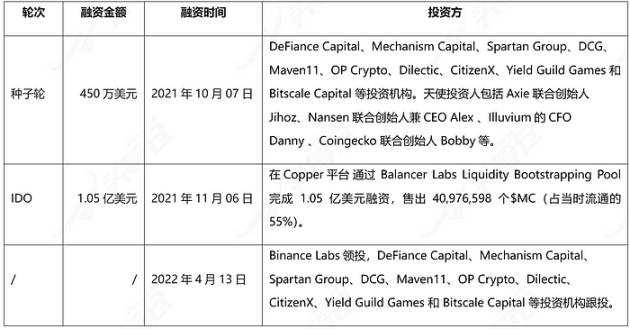
2.2.2 Treasury
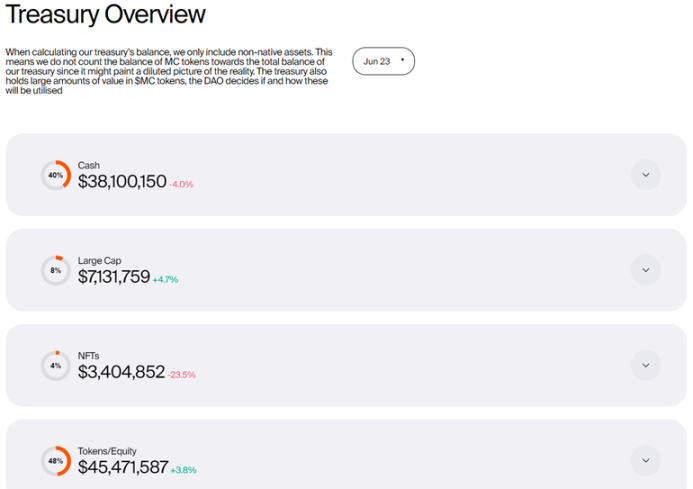
Figure 2-1 MeritCircle Treasury Assets Data as of June 23[8]
Merit Circle's treasury is divided into four parts (excluding held $MC), namely cash, blue-chip tokens, NFT assets, and tokens/equity related to the chain game track, with a treasury value of approximately $94.1 million. In addition, according to the official treasury address statistics, Merit Circle holds approximately 42.49 million $MC on Ethereum and BSC, calculated at approximately $12.83 million based on the current price, accounting for about 9.17% of the current total circulation.
2.3 Code
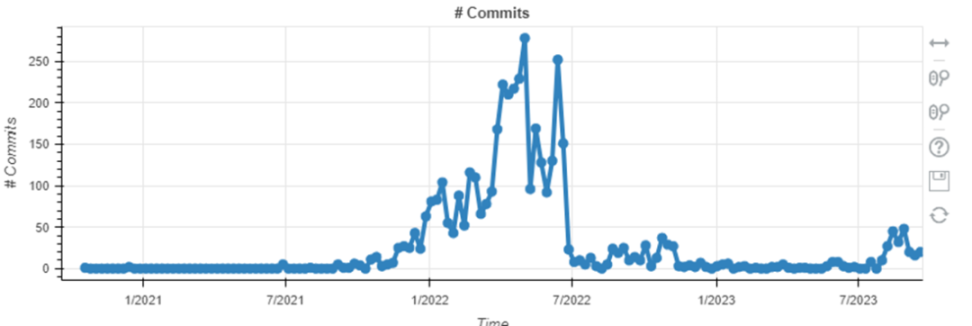
Figure 2-2 Merit Circle Code Submission Status[9]

Figure 2-3 MeritCircle Code Contributors
Merit Circle's code is open source on GitHub[10], with a total of 4578 code submissions and an average of 10 code contributors. The periods with relatively frequent code submissions are from March 2022 to June 2022, and from July 2023 to September 2023, corresponding to the development of the game NFT market Sphere (not yet released, news in February indicated it will be released this year) and the development of the Beam game chain built on the Avalanche Subnet.
2.4 Products
2.4.1 Product Introduction
Merit Circle (MC) is a decentralized DAO chain game guild built on Ethereum and BSC. Initially, Merit Circle was a scholarship guild similar to YGG, with scholarship business, SubDao model, etc. Considering the sustainability and limitations of the scholarship business, it began to transform the structure and positioning of the DAO in March 2022, hoping to build it into a game DAO, dividing the DAO into multiple sections (vertical fields). Currently, its main sections are investment, studio (building and incubating new projects), games (chain game market distribution platform), and infrastructure (Beam game chain built on Avalanche, which went live on August 18 this year). In addition, the game NFT platform Sphere, which is still in the development stage, was once one of the four main sections, but due to market factors, its release was postponed, and it was replaced by the infrastructure section.
2.4.2 Merit Circle Investment
1) Initial investment funds and sources;
Merit Circle's investment funds come from a $100 million USDC raised on the Copper platform, and an investment committee responsible for investments was formed according to MIP-2 proposal, with specific members being: Flow Ventures LP, Sergei Chan, CitizenX, and Maven11.
2) Investment details;
Merit Circle's investment section details are reflected in treasury allocation. According to treasury data as of June 23, cash allocation is mainly in USDC; blue-chip tokens mainly include WBTC, Uni V2 staking, and WETH; NFT assets mainly include Bigtime Land ($1 million), Axies NFT, and CyballNFT; tokens/equity related to the chain game track include investments in 79 projects (61 non-circulating, 18 circulating), with the majority being in the primary market of chain games, accounting for about 80% of the investment in tokens/equity related to the chain game track, and these games lean towards playability.
Figure 2-4 MeritCircle Treasury Allocation Details for Tokens/Equity Related to the Chain Game Track
Table 2-1 Major Investment Projects of MeritCircle (Treasury Allocation of 1% or More)
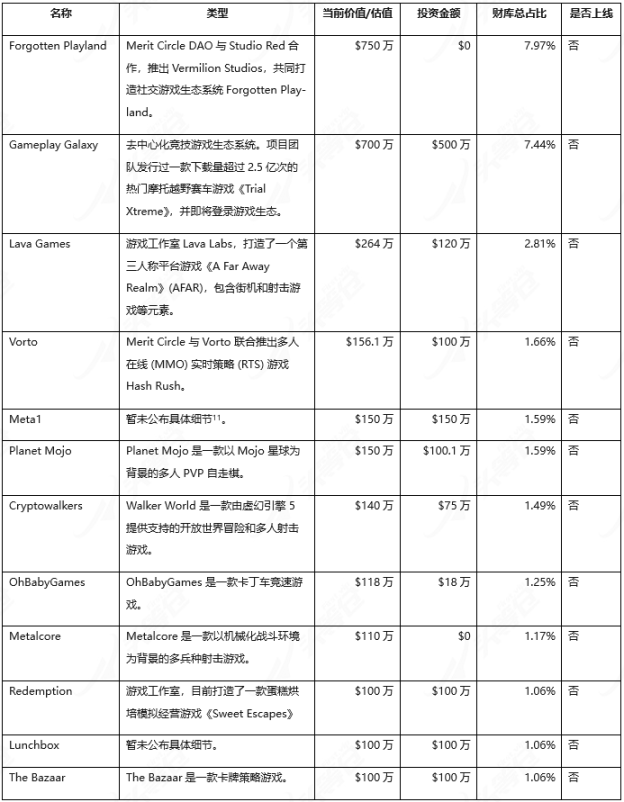
According to official data[12], the money spent on NFT assets is $4,834,000, currently valued at $3,404,852, resulting in a loss of $1,429,148 (-29.6%); the money spent on tokens/equity related to the chain game track is $28,045,486, currently valued at $45,471,587, resulting in a profit of $17,426,101 (+62.1%). The above data is not precise, and the actual valuation of NFT assets is lower due to liquidity. The valuation of tokens/equity related to the chain game track is based on market valuation, and most assets are not in circulation, so there is a certain margin of error.
Due to the investment sector being the main source of income for Merit Circle, and the strong correlation between the market value of $MC and the market value of the managed treasury assets, it is necessary to focus on analyzing the health of the invested projects. The current situation of projects accounting for more than 1% of the treasury is listed below:
①Forgotten Playland, current valuation $7.5 million, accounting for 7.97% of the total treasury
On April 25th of this year, Merit Circle announced a partnership with Studio Red to launch Vermilion Studios, creating a social game ecosystem called ForgottenPlayland. Currently, two small games have been revealed, one called "Bomb Pitchers," where players throw bombs at each other, trying to destroy opponents while avoiding being destroyed themselves. Energy items are scattered throughout the game, allowing players to make bombs more deadly through larger explosions and other enhancements. The other game, "Toy Limb Golf," is a golf game where players must run to the equipment warehouse and find quirky items such as toy limbs, baseball bats, and even teleport guns from science fiction novels to use as their "golf clubs." The official announcement states that 20 small games will be released in the future. Based on the information revealed, the game economy of Forgotten Playland mainly revolves around selling customizable skin NFTs, such as cosmetics and skins.
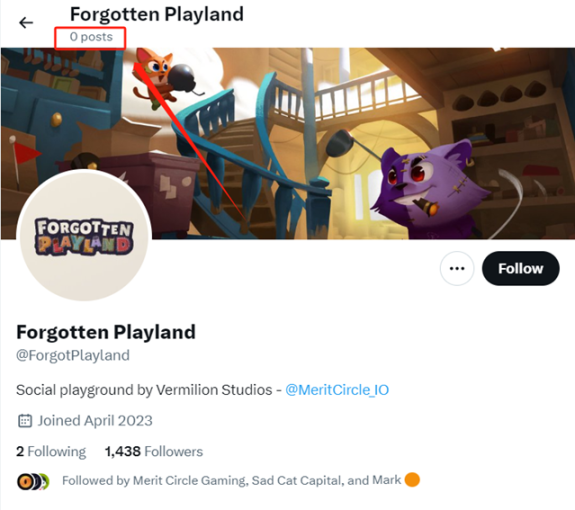
Figure 2-5 Official Twitter of ForgottenPlayland
Based on the official Twitter of ForgottenPlayland, there have been no tweets or related developments revealed since Merit Circle's announcement on April 25th. Therefore, the author believes that the current valuation of $7.5 million for this game has a significant amount of speculation and poor health. Additionally, the developed games are mostly small games, and the economic model is relatively average, with the current potential for future development being relatively low.
②Gameplay Galaxy, current valuation $7 million, accounting for 7.44% of the total treasury
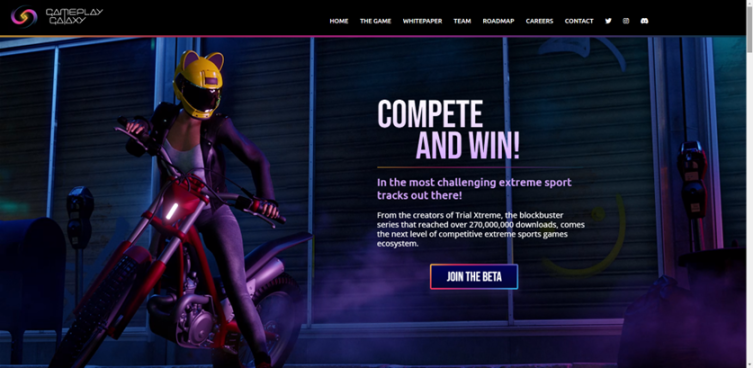
Figure 2-6 Official Website of GameplayGalaxy
Gameplay Galaxy is a Web3-driven decentralized competitive gaming ecosystem developed by the creators of the web2 game series "Trial Xtreme." The various motorcycle racing games in this series have been downloaded over 250 million times, with ratings of 4 stars on Google Play and 4.2 stars on the App Store (out of 5 stars). Gameplay Galaxy raised $12.8 million on September 7, 2022, with Blockchain Capital leading the investment, and Merit Circle (investing $5 million), Mysten Labs, Solana Ventures, Com2uS, Yield Guild Games, and Hustle Fund participating.
According to LinkedIn data, the team behind Gameplay Galaxy currently has a total of 41 employees, and co-founders Doron Kagan, Maya Gurevich, and Dmitry Burlakov each have over 15 years of experience in game entrepreneurship and work.
Gameplay Galaxy is migrating the web2 game "Trial Xtreme" to web3 and is currently in the beta testing phase, with testing qualifications available through email. Gameplay Galaxy has not yet issued tokens, and the project's white paper has not been detailed. According to the project roadmap, future updates will include the announcement of the rarity and utility mechanisms of NFTs, the launch of early access versions, security reviews, localization in different regions, official game release, and the launch of the NFT owner community, among other regular game updates.
The official Twitter account of Gameplay Galaxy (@TrialXtreme) has 17,577 followers and is still actively posting updates. However, the official Medium of GameplayGalaxy has not published any new content since the announcement on May 30.
In terms of the background of the game project, the game "Trial Xtreme" by GameplayGalaxy has a certain level of popularity and influence. The game has been in existence for over ten years since its release in 2009 and is one of the early well-known motorcycle racing games, belonging to a niche genre within the gaming industry with a stable player base. However, it still has a certain gap to become a mainstream popular game. In terms of the team background, the co-founders of Gameplay Galaxy each have over 15 years of experience in game entrepreneurship and work. In terms of funding, $12.8 million is sufficient to support this small game, as the game has been maturely operating in web2 for many years. Based on this information, the author believes that the health of this project is relatively good, although the probability of it becoming a popular hit is not high, it has a relatively solid foundation.
③Lava Games, current valuation $2.64 million, accounting for 2.81% of the total treasury
Lava Games is a game studio that has created a third-person platform game called "A Far Away Realm" (AFAR), which includes elements of arcade and shooting games. MeritCircle announced a partnership with "A Far Away Realm" (AFAR) on March 21, 2022, and invested $1.2 million in it.
The game started pre-registering for soft launch on Google Play on June 30 of this year but has not yet been launched. Its NFT collection AFAR - RAFA Genesis has only had a trading volume of 90 ETH on OpenSea, with the current floor price at 0.0099 ETH, indicating a lack of interest. In addition, the official Twitter account (@playafar) of the game has 46,451 followers, but has low tweet activity. Based on this information, the author believes that the health of this project is poor, and the current valuation of $2.64 million has a significant amount of speculation.
④Vorto, current valuation $1.561 million, accounting for 1.66% of the total treasury
On August 25, 2022, Merit Circle announced a joint launch with Vorto of the multiplayer online (MMO) real-time strategy (RTS) game "Hash Rush" and invested $1 million in it. The game is currently in the development stage, and the official website states that it will be released on the Beam chain in the future. Based on the official animation and visuals revealed by the project, the production quality is relatively average. It is worth noting that the project has been in development since July 2017, with intermittent progress and frequent changes in direction. In addition, the official Twitter account (@PlayHashRush) has only 9,117 followers. Based on this information, the author believes that the health of this project is poor, and the current valuation of $1.561 million has a significant amount of speculation.
⑤Others
Overall, it is observed that most of the gamefi projects invested in by Merit Circle are small games, and the survival rate of such chain games in a bear market is relatively low. Currently, nearly half of the treasury assets are used to invest in gamefi projects. If a blockbuster hit is not achieved, it poses a potential risk to the overall project.
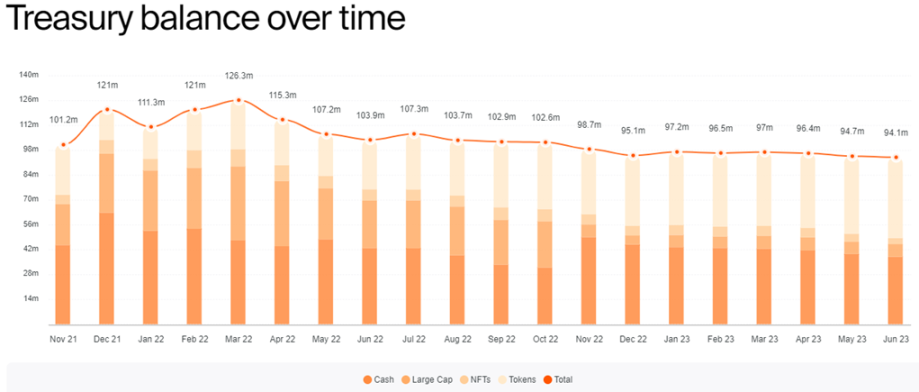
Figure 2-7 MeritCircle Treasury Funds Situation from November 2021 to June 2023
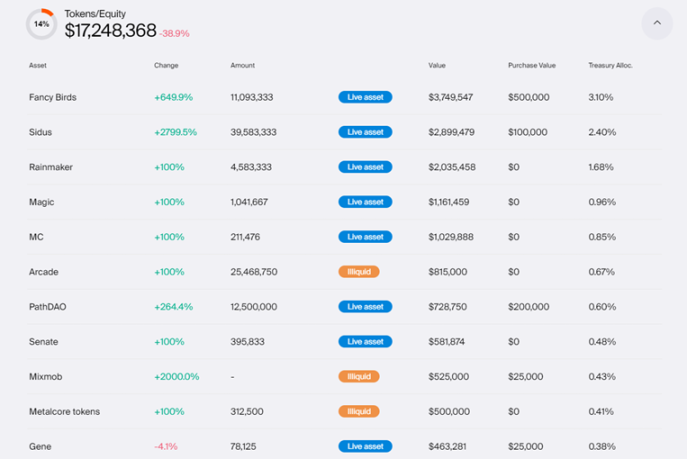
Figure 2-8 Allocation Details of Merit Circle Treasury Gamefi Tokens/Equity Investments in December 2021
As shown in Figure 2-7, during the market downturn period from November 2021 to June 2023, the overall shrinkage of the treasury is not significant, decreasing by about 7% compared to November 2021. The main reasons for this analysis are as follows:
①Cash allocation has been maintained at around $40-50 million, accounting for 40%-50% of the treasury;
②NFT assets with significant fluctuations and poor liquidity have been maintained at a low level, around 5%;
③According to Proposal MIP-6 for early-stage risk aversion authorization, a series of profit-taking and stop-loss requirements were proposed;
④The gamefi tokens/equity, a part of the risky assets, invested in the secondary market at the end of 2021 and the beginning of 2022 (as shown in Figure 2-8), intentionally reduced the holdings of these assets in the early stage of the downturn and shifted towards investing in the primary market of the gamefi track, with the investment proportion increasing monthly. Additionally, it is worth noting that the quality of the projects invested in this part of the investment assets is relatively average, mostly small games, and almost none have been launched, with a significant amount of speculation in their valuations.
From the above, it can be seen that Merit Circle tends to have a conservative investment style with a strong risk awareness, but there is a significant amount of speculation in the valuations of its investment projects.
3) Investment income distribution.
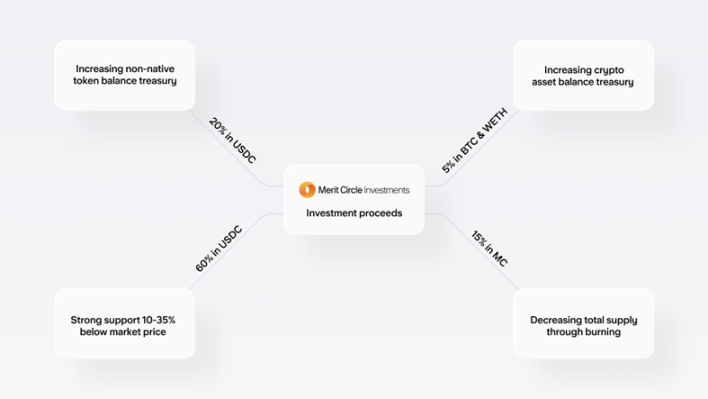
Figure 2-7 Investment Income Distribution Framework of MeritCircle
The investment income distribution framework was formulated according to Proposal MIP-7 for a sustainable future vision, as shown in Figure 2-7, specifically:
①20% of the income will be returned to the treasury in the form of USDC;
②5% of the income will be returned to the treasury in the form of encrypted assets (mainly ETH and WBTC);
③60% of the income will be used to repurchase $MC, with limit buy orders (10%-35% below market price), and the repurchased $MC will gradually become the main source of MC staking rewards (due to Proposal MIP-26 canceling V2 and V3 staking, the remaining approximately 9.5 million $MC that has not been allocated will be destroyed, and this fund may be used for Beam chain rewards in the future). Additionally, it can be sold to strategic investors for long-term lock-up or destruction, and is subject to DAO governance;
④15% of the income will be used to burn $MC.
2.4.3 Merit Circle Studios
The main function of Merit Circle Studios is to bring value to other sectors within the DAO ecosystem and is the birthplace of creative projects within the Merit Circle DAO, collaborating with existing projects and projects from non-web3 companies. Currently, Merit Circle Studios offers three services and products:
1) Merit Circle Grants
Grants are divided into research grants and development grants.
u Research grants, with a maximum of $10,000 per applicant, are intended to support research projects and lay the foundation for larger proposals decided by community voting. This grant is applicable to proposals that exceed this grant limit.
u Development grants, with a maximum of $25,000 per applicant, are intended to compensate developers for expenses incurred during project development.
Applicants can apply on Wonderverse, and the committee composed of DAO community members will review and vote on the applications.
2) Merit Circle NFT Collection Edenhorde
The Edenhorde NFT collection is the first creative project of the Merit Circle DAO (with a total of 8,800, currently at a floor price of 0.059 ETH on OpenSea, with a total trading volume of 10,103 ETH, a nearly 93.4% shrinkage from the average selling price of 0.9 ETH at its peak in March 2022, showing a trend of declining volume and price since its listing on OpenSea, with no significant rebound during this period. In addition, the trading situation has been bleak in the past two months, with only sporadic transactions every three to four days). The Edenhorde NFT collection was initially created by Emmy Award-winning illustrator Andy Ristaino, and the IP story behind the NFTs was written by "Edenhorde" author and historian Celia Blythe, with a total of eight episodes released so far.
Merit Circle aims to develop Edenhorde into an IP to enter the multimedia field, such as merchandise, animation, and games. Edenhorde can interact with creative incubation projects and collaborative projects of the Merit Circle DAO (for example, in the game Canverse, Edenhorde characters can be used as game pieces), and holders of Edenhorde can also receive 2.5% of the income from incubated projects (as shown in Figure 2-9, this allocation details are a rough framework, and may be modified in the future, specific details can be found in Proposal MIP-10). On August 21, a card game called Edenhorde Eclipse was released, currently in the alpha testing phase, and will be released on the Beam game chain in the future. Additionally, according to official announcements, a project called Project Amginea is in development, and there will be future releases of Edenhorde NFT staking.
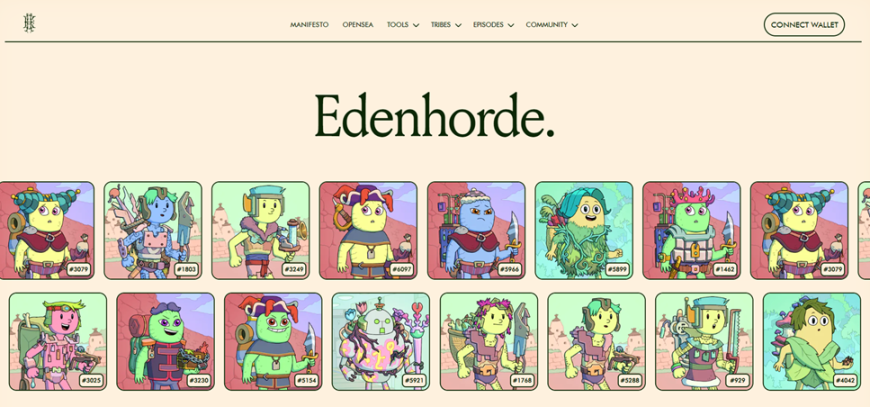
Figure 2-8 Edenhorde Official Website
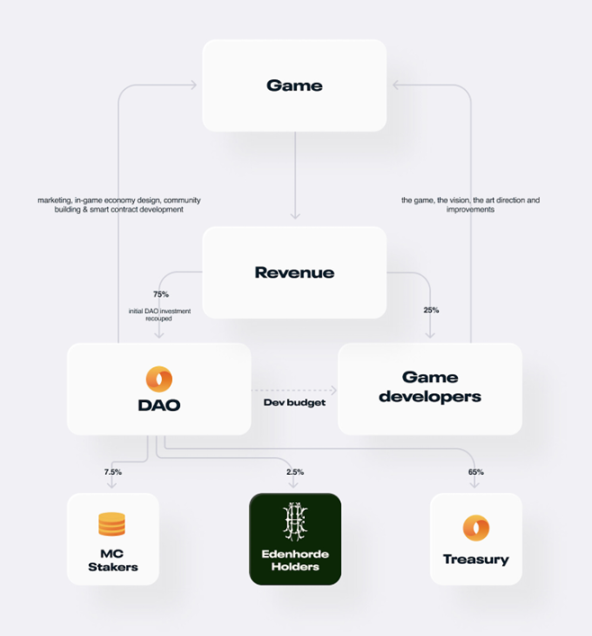
Figure 2-9 Income Distribution Framework for MeritCircle DAO Incubated Games
3) Merit Circle Tactile
According to Proposal MIP-22, Merit Circle Tactile is a set of 650 merchandise boxes specifically provided for the community, containing seven wearable items (T-shirts, hoodies, scarves, and hats). Holders of the Merit Circle Tactile NFT can obtain these merchandise boxes, and the NFT is distributed in two stages, with distribution targets including proposal creators, contributors, and a lottery for Edenhorde NFT holders, among others.
2.4.4 Merit Circle Games
At first, Merit Circle also had a gold farming business, namely the scholarship model. However, considering the sustainability and limitations of the scholarship business, Merit Circle decided to transform into its current gaming sector. The main functions of the current gaming sector are as follows: promoting and acquiring game users for cooperative games, providing learning tutorials for popular blockchain games to players, and offering early access to games for Merit Circle gaming community users, allowing players to earn rewards (NFTs, lottery, etc.) by completing tasks.
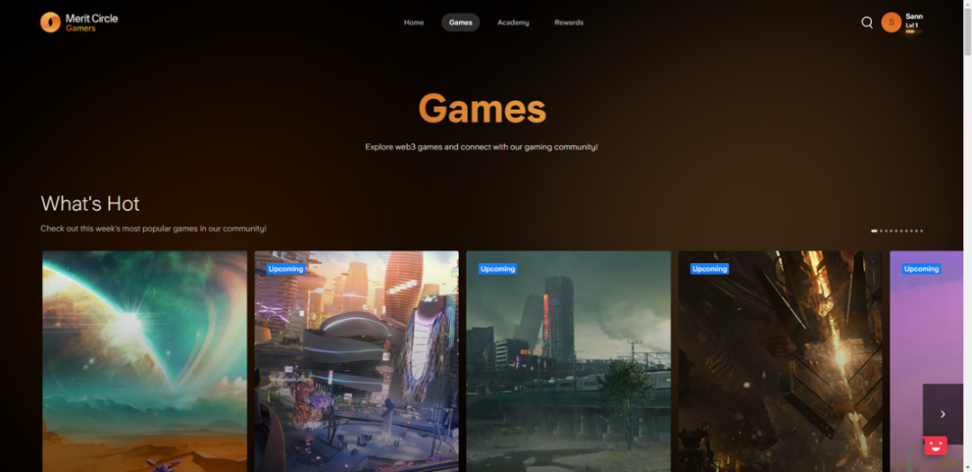
Figure 2-10 Game Interface of the Gaming Sector
The game interface introduces popular games on the market, games available for early access, games collaborated with Merit Circle, upcoming competitions, free-to-play games, and game tournaments.
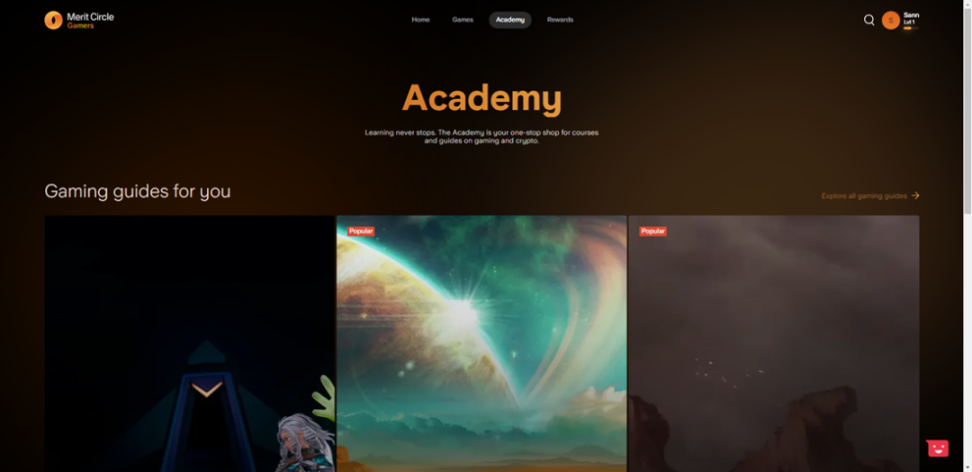
Figure 2-11 Academy Interface of the Gaming Sector
The academy provides players with introductory tutorials on web3 and tutorials for popular blockchain games.
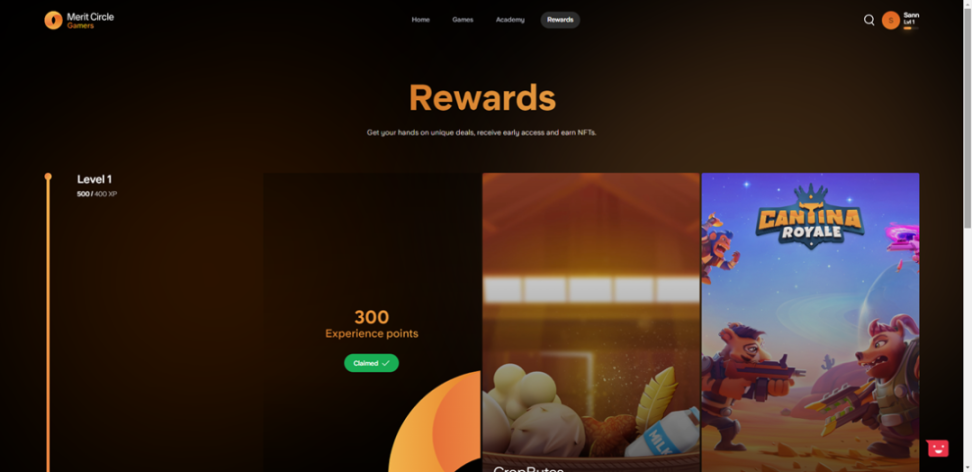
Figure 2-12 Reward Interface of the Gaming Sector
Players can earn experience points by registering and logging in daily. The rewards mainly include lottery and related game NFTs. As the level increases, players can receive more tasks and rewards. For example, at Level 1, players can earn rewards by completing tasks for the game CropBytes, with a chance to win game NFT props through a lottery within the deadline.
2.4.5 Merit Circle Infrastructure
Merit Circle's infrastructure is built around gaming. The infrastructure product currently released is the Beam game chain built on Avalanche, which went live on the mainnet on August 18 this year. According to Proposal MIP-27, 75 million $MC (valued at approximately $22.5 million based on the current token price) will be allocated from the treasury to provide liquidity, support game/game developers (for paying gas fees), and verify and protect the Beam network. Additionally, 2.7 million USDC will be allocated from the treasury for the development of Beam and ecosystem products (with $200,000 allocated for AMM liquidity on Beam).
The Beam game chain uses a POS consensus mechanism, allowing users to become validator nodes by staking $AVAX or $MC, using $MC as gas fees, utilizing LayerZero as the official cross-chain bridge, and using Openfort to provide account abstract wallets and integration services.
It is worth noting that according to Proposal MIP-28, by the end of this year, $MC may be migrated to $BEAM at a ratio of 1:100 (where $MC will still be the platform token before the migration). However, the name Merit Circle will continue to be the overall brand associated with the Beam network and $BEAM. After the migration, $MC will be associated with outdated information from the initial stage of Merit Circle, and $BEAM will be used as the token for gas consumption and node staking on the Beam chain. After the migration is completed, it will be necessary to pay attention to whether there will be significant changes to the economic model.
According to official sources, the ecosystem games to be released on the chain include: the popular off-road motorcycle racing game "Trial Xtreme" with over 250 million downloads developed by Gameplay Galaxy; the social deduction game "Castle of Blackwater"; "Megaweapon," a multiplayer battle shooting game; "Walker World," an open-world adventure and multiplayer shooting game supported by Unreal Engine 5; the multiplayer online (MMO) real-time strategy (RTS) game "Hash Rush" jointly launched by Merit Circle DAO and Vorto; "Edenhorde Eclipse," a card game incubated by Merit Circle, playable with Edenhorde NFTs; in addition, the game NFT trading market Sphere will also be launched later.
Summary:
From the development roadmap, Merit Circle has transformed into a gaming DAO, which is quite different from traditional decentralized blockchain gaming guilds. Its main product business no longer relies on the scholarship model, but gradually expands into the mid-to-high-end blockchain gaming industry through investments in the primary market of blockchain games, game development partnerships, building distribution channel platforms for blockchain games, and infrastructure construction.
Looking at the four major business sectors of Merit Circle, the investment sector is currently the main source of income and is the core of the business, requiring close attention. Merit Circle's investment style tends to be conservative with a strong risk awareness. Currently, the main investments are in the primary market of blockchain games, and most of the invested games are small games with significant speculation in their current valuations. The survival probability of these projects in a bear market is not high. However, the treasury still holds approximately $45 million in cash and highly liquid blue-chip coins, accounting for 48% of the treasury, indicating relatively ample funds. The studio sector can bring value to other sectors within the DAO ecosystem and is the birthplace of creative projects within the Merit Circle DAO. Currently, the development of the studio sector is still in its early stages, with no significant profit benefits, and the quality of the developed incubation projects is relatively average. The gaming sector currently functions as a distribution channel for blockchain games, promoting games to game developers to acquire users, providing learning tutorials for popular blockchain games to the Merit Circle gaming community, and offering opportunities to access games early and earn rewards (NFTs, lottery, etc.). However, the gaming sector currently does not generate profits and has relatively weak user appeal. The infrastructure sector has expanded the application scenarios of $MC, with the potential to raise expectations and project ceilings. Many of the invested projects claim to be released on the Beam chain, and it will be necessary to observe the landing of the on-chain gaming ecosystem in the future.
3. Development
3.1 History
Table 3-1 Major Events of MeritCircle[20]
July 2021
The predecessor of Merit Circle, Axie 420 scholarship organization, was established.
August 2021
Received a $200,000 investment from Flow Ventures, with two co-founders of Flow Ventures joining the team.
August 16, 2021
The predecessor of Merit Circle, Axie 420 scholarship, raised $1,250,000.
September 1, 2021
Renamed as Merit Circle DAO.
October 7, 2021
Received a $4.5 million investment from investment institutions including DeFiance Capital, Mechanism Capital, Spartan Group, DCG, Maven11, OP Crypto, Dilectic, CitizenX, Yield Guild Games, and Bitscale Capital. Angel investors include Jihoz, co-founder of Axie; Alex, co-founder and CEO of Nasen; Danny, CFO of Illuvium; and Bobby, co-founder of Coingecko, among others.
October 12, 2021
Introduced the project token $MC.
November 2, 2021
On the Copper platform, Merit Circle completed a $105 million financing through the Balancer Labs LiquidityBootstrapping Pool, selling 40,976,598 $MC (accounting for 55% of the circulating supply at the time).
November 7, 2021
$MC staking and liquidity mining rewards were launched.
November 12, 2021
DAO governance was initiated.
November 16, 2021
DAO treasury investments were initiated.
December 22, 2021
Collaborated with Big Time Studios and acquired land worth $1,000,000.
December 2, 2021
Launched on Binance Launchpool, providing 12,500,000 $MC mining rewards.
February 14, 2022
Released the NFT collection Edenhorde.
March 3, 2022
Transitioned to a gaming DAO, with the main business sectors being: investment, studio, game NFT market, and gaming.
May 28, 2022
Proposals MIP-13 and MIP-14 were approved, buying out the allocation of YGG and Nifty funds at a price of $0.32, totaling 5,468,750 $MC tokens. A total of $1,750,000 USDC.
September 9, 2022
Collaborated with Gameplay Galaxy and invested $5,000,000.
October 26, 2022
Proposal MIP-20 was approved, leading to the destruction of 2 billion $MC from the community incentive allocation, valued at $1.47 billion, due to the lack of utility of the allocated $M tokens.
November 7, 2022
$MC V2 staking was initiated.
January 31, 2023
Collaborated with Oh Baby Games and invested $180,000.
February 9, 2023
Announced plans to launch the game NFT market Sphere later this year.
February 24, 2023
The $MC allocated to initial contributors was changed from a four-year vesting period to a four-year lock-up period, involving a total of 71,700,000 $MC.
April 19, 2023
Announced a collaboration with Avalanche to launch the Beam game chain subnet.
August 18, 2023
The Beam game chain based on the Avalanche Subnet went live on the mainnet.
August 21, 2023
Released the Edenhorde Eclipse card game.
3.2 Current Status
3.2.1 Media Attention
Table 3-2 Media Attention

3.2.2 Operational Data
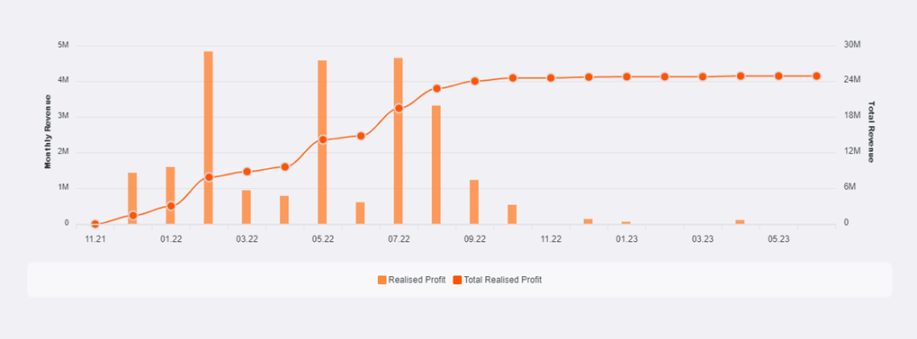
Figure 3-1 Detailed Historical Revenue
As of June 23, 2023, Merit Circle has accumulated a revenue of $24.09 million, with the majority of the revenue coming in 2022. The revenue for the first half of this year was only $180,000.
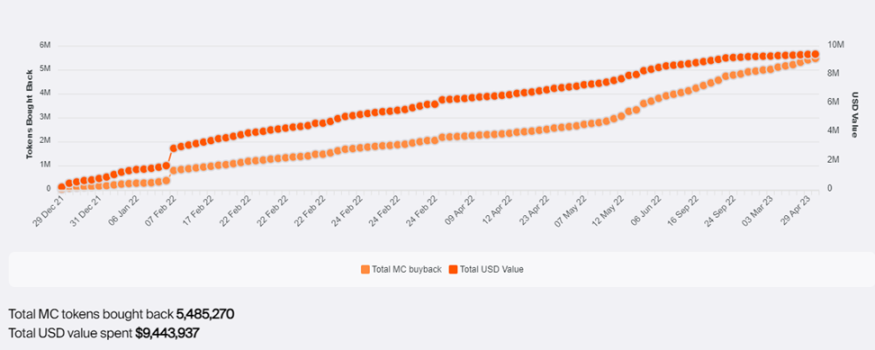
Figure 3-2 $MC Buyback Details
As of June 23, 2023, a total of 5,485,270 $MC has been repurchased, with a total expenditure of $9,443,937, accounting for approximately 39.2% of the revenue during the same period, with the main buyback period also being in 2022.
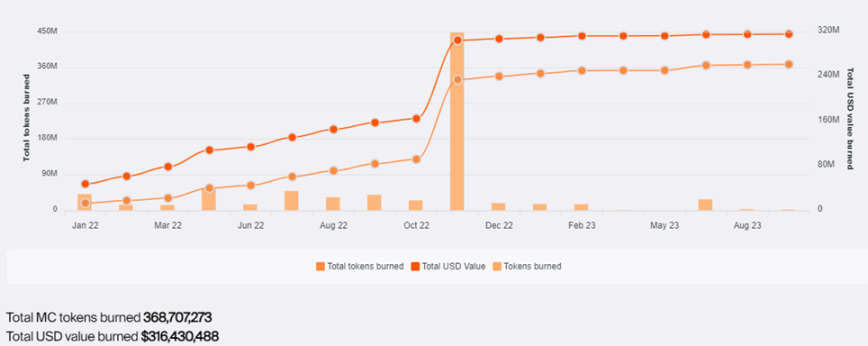
Figure 3-3 $MC Burn Details
As of September 23, 2023, a total of 368,707,273 $MC has been burned, with a cumulative value of $316,430,488, reducing the total supply from 1 billion to 631,292,726. The main sources of the burn include: according to Proposal MIP7, 75% of unused tokens are burned monthly from the community incentive allocation, and 15% of investment returns are used for burning $MC; according to Proposal MIP-20, 2 billion $MC was burned from the community incentive allocation (2.94 billion $MC) on October 26, 2022, valued at $1.47 billion.
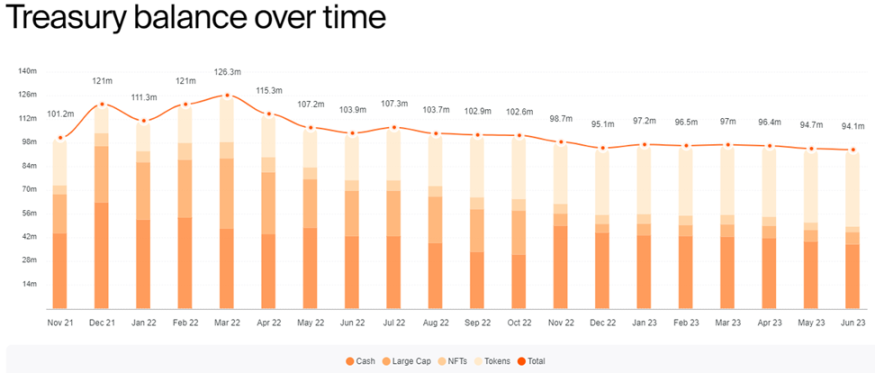
Figure 3-4 MeritCircle Treasury Allocation from November 2021 to June 2023
During the market downturn from November 2021 to June 2023, the overall treasury shrinkage of Merit Circle was not significant, decreasing by approximately 7% compared to November 2021.

Figure 3-5 Stake Staking Provided by Merit Circle
According to Proposal MIP-19, from November 8, 2022, to November 2023, 30,000,000 MC was used for V2 staking rewards. Before the end of the year, a new staking policy vote will be conducted to determine the rewards for the next year. 20% of the liquidity mining rewards are allocated to the single-coin pool, and 80% are allocated to the MC/ETH pool. The $MC earnings from staking have a custom lock-up period, with different reward weights based on the duration of the lock-up. For example: no lock-up period has a weight of 1; 12-month lock-up period has a weight of 1.65; 24-month lock-up period has a weight of 2.5; 48-month lock-up period has a weight of 6. In addition, the $MC from investment returns repurchase is also used for staking rewards.
However, according to Proposal MIP-26 on June 30, 2023, Merit Circle will cancel the remaining V2 staking plan four months early, and all stakers' positions will be unlocked. The accumulated $MC rewards from staking can be claimed, and the remaining approximately 9.5 million $MC will be burned. The project team stated that although the current staking plan has been canceled and further rewards have been stopped, they do not rule out the possibility of implementing a new staking plan or exploring alternative solutions in the future.
3.3 Future
The official roadmap has not been released at this time.
4. Economic Model
4.1 Token Distribution
The initial total supply of $MC is 1 billion, with the specific distribution as shown in Table 4-1. Subsequently, through community voting and the use of a portion of the income for burning, nearly one-third has been burned, reducing the total supply to 631,292,726 as of the writing date of September 18.
It is worth noting that, according to Proposal MIP-28, by the end of this year, there may be a migration of $MC to $BEAM at a ratio of 1:100 (where $MC will still be the platform token of the project before the migration). However, the name Merit Circle will continue to be used as the overall brand associated with the Beam network and $BEAM. After the migration, $MC will be associated with outdated information from the initial stage of Merit Circle, and $BEAM will serve as the gas consumption and node staking token for the Beam chain. After the migration is completed, it will be necessary to pay attention to whether there will be significant changes in the economic model.
Table 4-1 Initial Allocation of $MC[21]
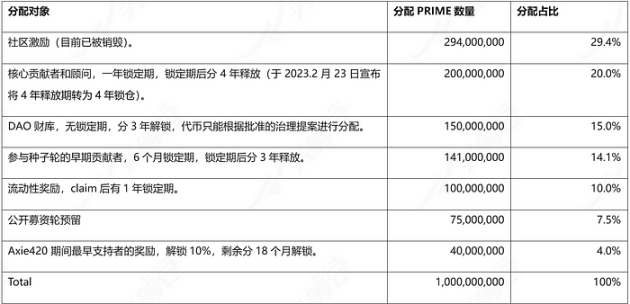
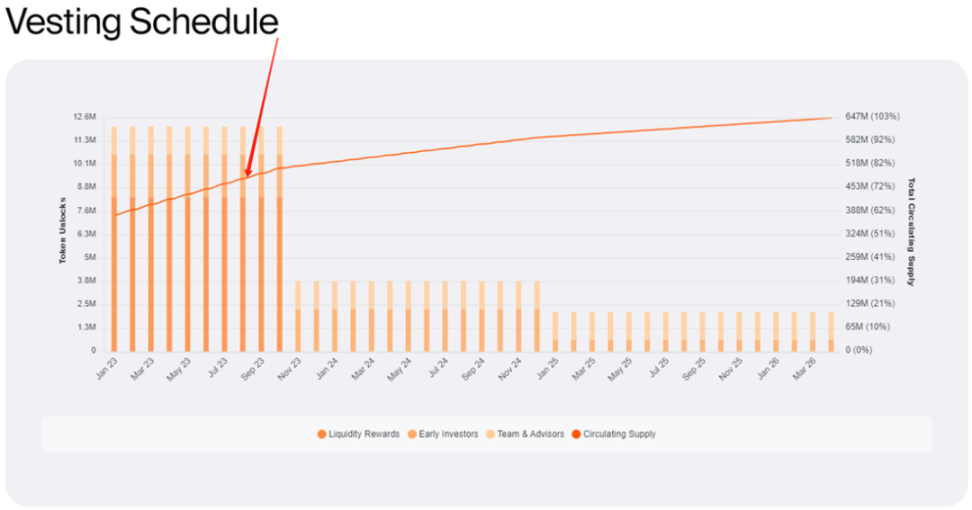
Figure 4-1 $MC Unlocking Table
4.2 Token Holder Address Analysis
According to Ethereum browser and Nansen data, as of September 22, 2023, the total number of $MC holder addresses is 11,995. The top 100 $MC holder addresses collectively hold 91.99% of the total, with the top 10 addresses holding 75.63%. The top 10 addresses mainly consist of contract addresses, multi-signature contract addresses, team advisor unlocking contracts, Binance hot wallets, and staking pool contracts, with no individual wallet addresses, indicating a relatively dispersed overall holding.
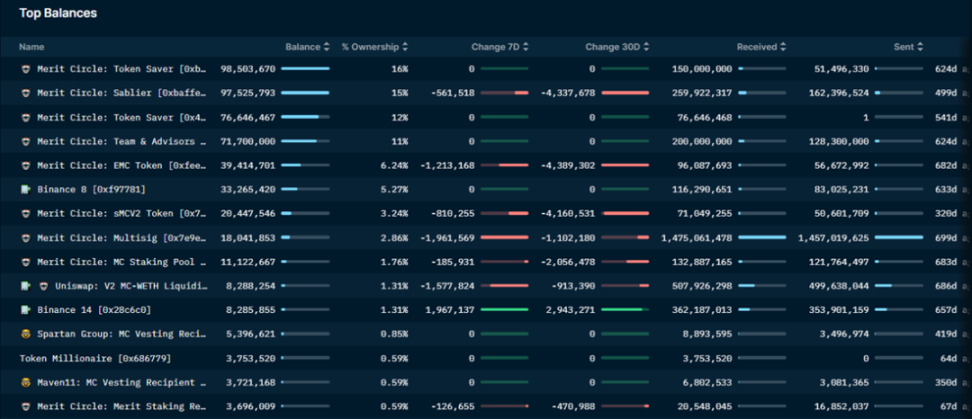
Figure 4-2 $MC Holder Address Information, from Nansen[22]
Looking at the changes in holder addresses, there has been a noticeable increase in the number of holder addresses after October 29, 2022.
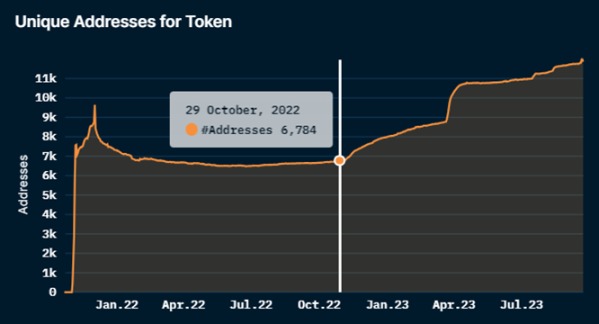
Figure 4-3 Changes in Holder Addresses, from Nansen
4.3 Governance
Most of the major decisions of Merit Circle are determined by governance proposals[23]. As of now, there have been a total of 27 proposals, with several important ones listed below: MIP-1 passed the public sale through the Balancer Labs Liquidity Bootstrapping Pool on the Copper platform, MIP-6 proposed a series of profit-taking and stop-loss requirements for early-stage risk mitigation authorization, MIP-7 established investment allocation and burning measures, MIP-13 and 14 bought out the allocation of YGG and Nifty funds for $1.75 million, MIP-17DAO architecture restructuring, MIP-20 burned 2 billion $MC from the community incentive allocation, MIP-27 allocated funds for Beam development, and more.
The governance proposal terms of Merit Circle are clear and transparent, and a governance forum has been specifically created for discussion. However, it appears that the main proposals are currently being put forward by the project team.
4.4 Token Demand
1) Used as gas for the Beam game and for staking verification nodes; 2) Staking $MC can generate income from the pre-allocated rewards and the investment sector; 3) Governance voting.
5. Competition
Merit Circle operates in the chain game guild track, but it has shown significant differences in development routes compared to traditional chain game guilds. Merit Circle has abandoned the scholarship model and gradually expanded into the mid-to-high-end chain game industry through methods such as investing in the primary market of chain games, collaborating to develop games, building distribution platforms for chain games, and constructing infrastructure.
5.1 Track Overview[24]
In the traditional gaming field, the formation of game guilds is to allow players to gather and cooperate to conquer dungeons or collectively defeat big bosses. For example, in "World of Warcraft," top guilds often compete for the first clear of various dungeons or the first kill of monsters. In addition to these highly cooperative guilds, traditional game guilds also focus on player socialization and game content sharing, becoming the community hub for gamers.
In Web3, due to the rise of the Gamefi track in 2021, the explosive popularity of Axie Infinity has sparked a frenzy among blockchain players. However, for many low-income country gamers, the cost of configuring a pet that costs $600 and often requires three pets to start battling is unaffordable. In this environment, the emergence of chain game guilds has greatly reduced the barrier for players to enter Play-to-Earn (P2E) games. The scholarship model pioneered by Yield Guild Games has led to the rise of chain game guilds.
The scholarship model was one of the core businesses of chain game guilds in the previous Gamefi Summer bull market. Its operation logic is that the game guild provides the game items required for Gamefi and recruits community managers. The community managers recruit and train Play-to-Earn (P2E) players (scholars). Qualified players use the game items provided by the game guild for Gamefi, and the earnings from Gamefi are then distributed proportionally between the game guild and the community managers.
As chain game guilds have developed over the past two years, they have gradually shown the following characteristics:
1) Limitations of the scholarship mechanism: The scholarship mechanism essentially helps bring in a player base focused on Play-to-Earn (P2E) for Gamefi. This player base can help attract attention to the game and expand the game community in the early stages. However, once in the mid-to-late stages, in the current situation where the token model of the chain game track is generally immature and the death spiral dilemma is common, the large number of P2E players and the heavy game assets (NFT game items) held by chain game guilds pose a serious threat to the game itself and can accelerate the collapse of the Gamefi economic model.
This means that the operation of the scholarship system is not sustainable in a single Gamefi. Guilds need to constantly seek profitable Gamefi to make a profit, and during bear markets, there are not many profitable Gamefi, leading to significant cyclical changes in guild income.
In addition, the current common scholarship mechanism of chain game guilds only applies to P2E mode games, and P2E mode games without exception are currently heading towards a downturn. In the long run, it is uncertain whether P2E mode chain games will continue to exist or decline.
As the Gamefi track develops and matures, more and more Gamefi are beginning to have their own leasing systems, such as Starshark and Pegaxy. The emergence of leasing systems will also put pressure on the audience of the scholarship system. Once more players choose to use leasing systems instead of participating in profit-sharing scholarship systems like YGG, the income of such guilds will significantly decrease.
2) Strong regional nature of guilds: Currently, mainstream guilds are mainly distributed in Southeast Asia. For example, the largest guild in this track, YGG, has its main community players in the Philippines. GuildFi, which is dedicated to developing Guild-As-a-Service (Gaas), has its main community located in Thailand, and the largest chain game guild in Vietnam is Ancient8.
3) Future development showing fundization and functionalization: After the success of the scholarship model, guilds began looking for the next "Axie Infinity." Therefore, current guilds generally participate in the early NFT presales of chain game projects, aiming to obtain a certain number of NFTs early on through collaboration in preparation for the game's launch later on.
In addition to NFTs, guilds may even serve as early investors in many chain game projects, transforming their role from intermediaries in NFT leasing to players' communities into venture capital funds in the chain game track. In addition to the direction of fundization, guilds are also exploring other development directions, such as developing infrastructure, incubating game development, providing data services, community services, traffic services, and systematic management services for the guild's scholarship and revenue systems, moving towards functional development.
4. Highly Dependent on the Development of the Chain Game Track: The income of chain game guilds, whether relying on the commission of the scholarship mechanism or the return on investment in Gamefi, is built on the development of the chain game track. The chain game track is currently in its early stages, with significant room for growth in the future. For a game guild, the ability to grow with this track and ensure the continuous profitability of its investment portfolio is crucial.
5.2 Competitive Comparison[25]
1) Yield Guild Games (YGG)
YGG is a decentralized chain game guild built on ETH and Polygon, and it pioneered the scholarship model that drove the rise of the chain game guild track. However, due to the current quietness of the chain game track, the limitations of the scholarship model are gradually becoming apparent. YGG is shifting its development focus towards investing in high-quality games rather than purely P2E games. Initially, Merit Circle was similar to YGG, with scholarship business and SubDao models. However, considering the sustainability and limitations of the scholarship business, and the fact that these businesses are almost all overshadowed by YGG, it began to transform the structure and positioning of the DAO in March 2022, hoping to build Merit Circle into a game DAO.
2) GuildFi (GF)
GF is a chain game guild and guild service platform built on Ethereum. The project is currently attempting to move towards fundization and functionalization, providing early-stage financing for game communities and post-launch guild-related services.
5.2.1 Competitive Business Development
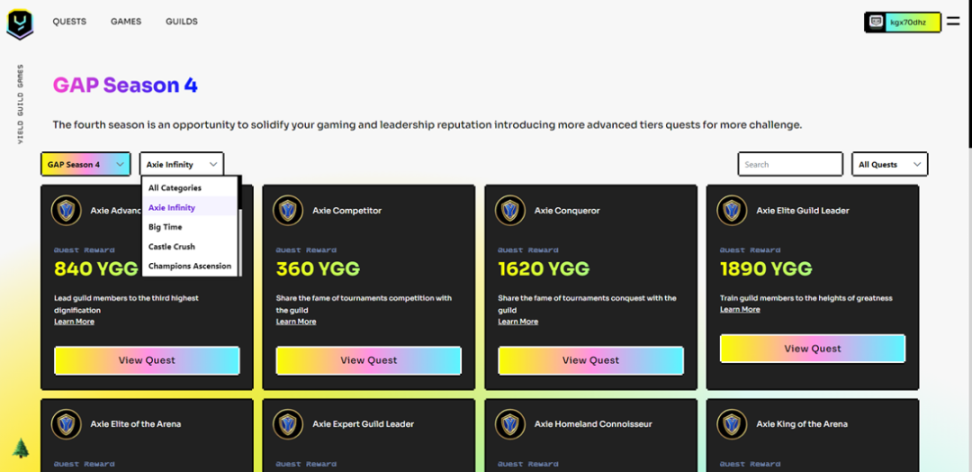
Figure 5-1 YGGGAP Season 4 Task List
YGG's current focus is on collaborating with popular games and related projects, investing in and incubating games, guilds, and infrastructure related to the track, hosting web3 micro-competitive events and activities to continue expanding the community. The once core scholarship business has shown a reduction in each quarter in 2022, and no scholarship business-related data was disclosed in the community reports for Q1 and Q2 of this year.
Currently, YGG's community operations mainly revolve around the Quest game task system, primarily through the launch of the Guild Advancement Program (GAP) to expand the community and enhance community cohesion, promoting collaboration between community members and cooperative games. Participants need to complete achievement tasks released by YGG, such as reaching a certain duration in cooperative games, recruiting a certain number of players to join YGG, and hosting high-quality streaming content to receive YGG token rewards and corresponding NFTs. This program is one of the current key directions of YGG's development, currently in its fourth season, GAP Season 4. As shown in Figure 5-1, GAP Season 4 offers a total of 14 task sets, providing over 150 tasks in total. However, these tasks are relatively difficult to accomplish, with low income for players who complete them, and all rewards are in $YGG tokens, making them relatively less attractive. But compared to the NFT rewards and lotteries provided by Merit Circle's game sector, YGG's Quest rewards appear to be slightly more generous.
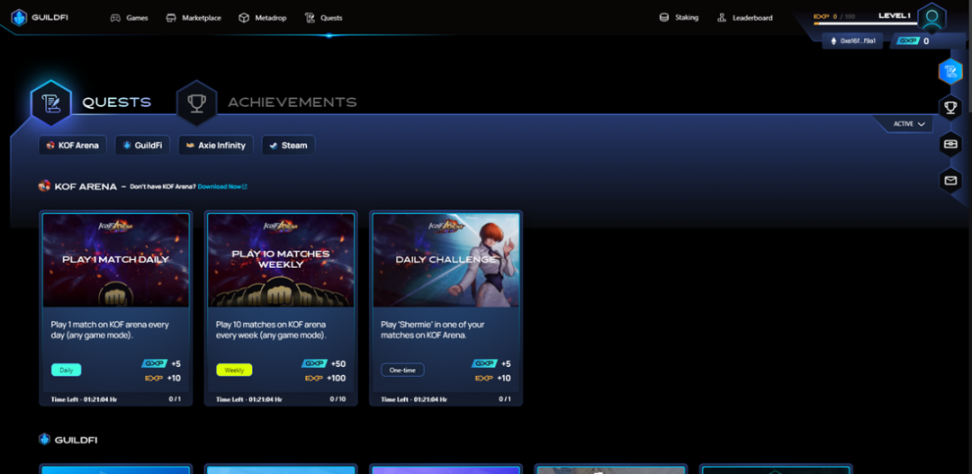
Figure 5-2 GuildFi Task System
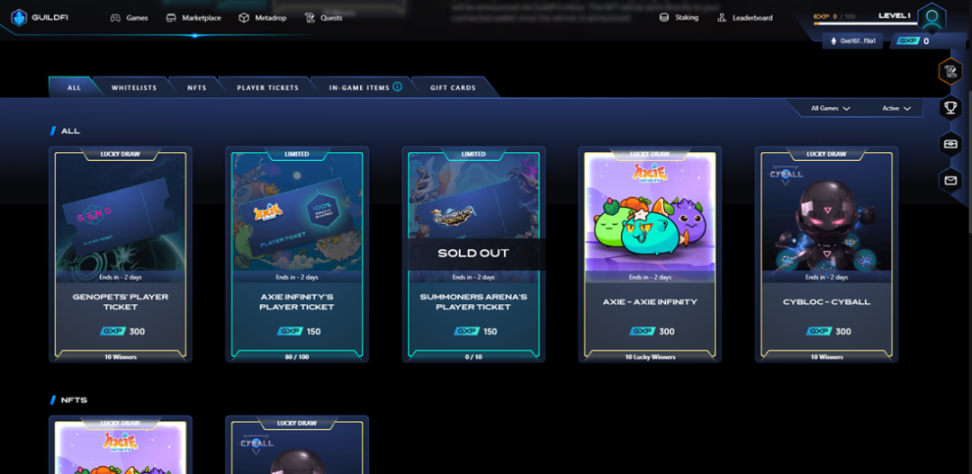
Figure 5-3 GuildFi Reward Market
GuildFi's current community operations are mainly carried out through the task system and reward market. Players complete provided tasks to earn GXP points, which can be used to exchange for game whitelist qualifications, game NFTs, game tickets, in-game items, and gift cards (mainly for Axie Infinity). The categories available for exchange are limited, and the value is relatively low.
Table 5-1 Community Data

In terms of community size and community operations, both Merit Circle and GuildFi have relatively weak community foundations due to the lack of attractive Play-to-Earn business and community activities. YGG has a first-mover advantage and has accumulated a certain community base through its previous scholarship model and SubDAO mechanism. However, at present, all three lack the ability to attract new users and retain old users.
5.1.2 Financial Data Comparison
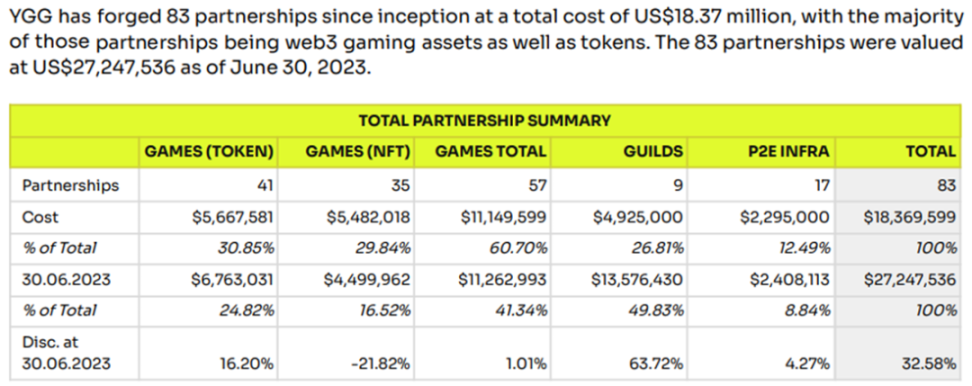
Figure 5-4 YGG Q2 Investment Disclosure[26]

Figure 5-5 GuildFi 2023 Mid-Year Financial Update[27]
Table 5-2 Investment Disclosure Comparison of YGG, Merit Circle, and GuildFi
YGG disclosed financial information in its Q2 2023 community update document, revealing that from its establishment to Q2 2023, it has invested in a total of 83 projects related to the chain game track. This includes investments in 41 types of game tokens, 35 types of game NFT assets, 57 games, 9 chain game guilds, and 17 P2E infrastructures. The cost of these investments was $18.37 million, and as of June 30, 2023, the value of these investments was approximately $27.25 million, with a profit of about 32.58%. In addition to its own treasury investments, YGG also raised $75 million on February 18 this year to establish a venture capital fund called YGG Ventures Fund I, which is used to invest in early token and equity transactions of web3, game studios, and infrastructure supporting industry development.
As of June 23, 2023, Merit Circle's treasury size is $94.1 million, divided into four parts as follows: 40% in cash, mainly in USDC; 8% in blue-chip coins, mainly WBTC, Uni V2 staking, and WETH; 4% in NFT assets, mainly in BigtimeLand ($1 million), Axies NFT, and Cyball NFT; and 48% in chain game-related tokens/equity, with investments in 79 projects (61 non-circulating, 18 circulating), mainly in the primary market of the chain game track, accounting for approximately 80% of the investment in chain game-related tokens/equity.
In terms of investment performance, Merit Circle appears to be more outstanding compared to YGG and GuildFi on the surface. However, the projects invested in by Merit Circle are mostly non-circulating equity, and based on the current quality of the projects invested in, their valuations generally have a significant amount of speculation. This means that the actual investment situation of Merit Circle may result in greater losses, although the specific losses are difficult to calculate. However, Merit Circle does have better risk control capabilities, a larger capital scale, and relatively transparent financial disclosure (monthly updates and public dashboards). On the other hand, GuildFi has lower overall investment and participation in the chain game market, weaker competitiveness, and seems to have a passive approach. In terms of investment and cooperation targets, compared to Merit Circle and GuildFi, YGG has a competitive advantage in the quality of games invested in and cooperated with, as well as a better brand effect.
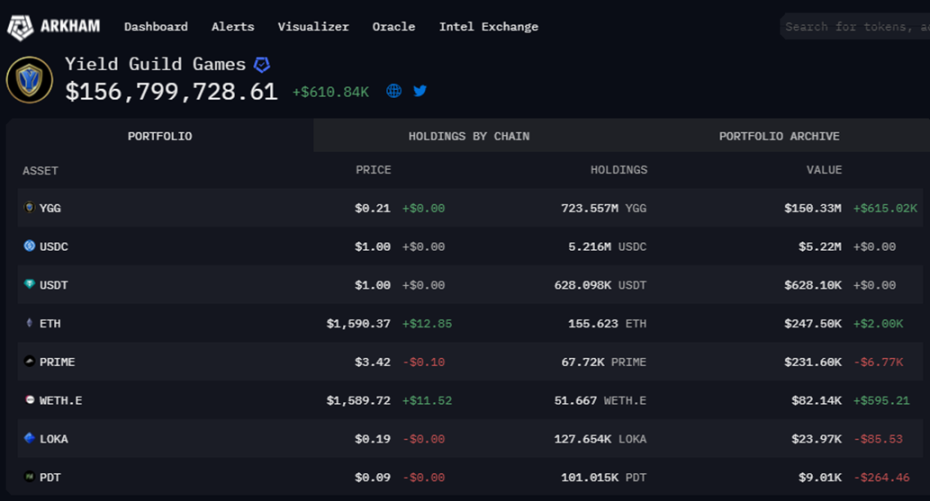
Figure 5-6 YGG Treasury Situation[28]
YGG's treasury currently holds tokens worth $157 million, with approximately $724 million in $YGG, currently valued at $150 million, accounting for 95.54%, and stablecoins and other circulating tokens currently valued at $7 million, accounting for 4.46%.
As of June 23, 2023, Merit Circle disclosed a treasury size of $94.1 million, with stablecoins and blue-chip coins valued at approximately $45 million. According to the official treasury wallet addresses provided, Merit Circle holds approximately $42.49 million in $MC on Ethereum and BSC, currently valued at approximately $12.83 million, accounting for approximately 9.17% of the current total circulation.
In its mid-year report released on July 26, GuildFi stated that its total treasury funds are approximately $92.68 million, divided into three parts: stablecoins, BTC, ETH, and LP, approximately $71.89 million; tokens and the primary market, approximately $15.91 million; and NFT assets, approximately $4.89 million. However, based on the current holdings of the five treasury addresses publicly disclosed, the total funds amount to approximately $42.26 million, with the $GF token valued at approximately $7.35 million, and the majority being stablecoins, ETH, and LP. In addition, two significant transfers from the main treasury addresses to Binance were made, with amounts of $8 million USDT and $2.97 million USDT, with the official statement indicating that these funds are mainly used to support daily operations and repurchase tokens from investors.
In terms of treasury funds, YGG holds a large amount of $YGG, accounting for as much as 95.54%, with stablecoins and other circulating tokens amounting to only $7 million, accounting for 4.46%. On the other hand, the treasury allocation of Merit Circle and GuildFi is more reasonable, with the former's stablecoins and blue-chip coins accounting for nearly 50%, valued at approximately $45 million. The latter's stablecoins and blue-chip coins account for approximately 71.9%[29], valued at approximately $53.23 million. Additionally, the $MC token has a relatively high circulation unlock ratio, approximately 73.32% ($YGG is 18.51%, $GF is 42.56%), and also has a token burning and repurchase mechanism, with a total of 368,707,273 $MC burned and 5,485,270 $MC repurchased. Furthermore, $MC can also be used for gas consumption on the Beam chain and node staking, while YGG and GuildFi currently lack token burning and repurchase mechanisms, and their token empowerment is weaker compared to $MC.
The cash and high liquidity token market value in the treasuries of Merit Circle and GuildFi are similar, but there is a significant difference in their market values. Currently, the liquid market value of $GF is approximately $20.38 million, with a fully circulating market value of approximately $47.86 million, both of which are lower than the current total treasury funds of $74 million (including $53.23 million from the mid-year report, NFT, and investment project values). On the other hand, the liquid market value of $MC is approximately $140 million, with a fully circulating market value of approximately $195 million, both of which are higher than the current total treasury funds of $94.1 million. The reasons for this difference may be as follows:
1) Although Merit Circle and GuildFi have similar cash flows and both invest in projects of average quality, Merit Circle has a larger investment scale, indicating a more proactive layout and participation in the industry, while GuildFi seems to have a passive approach, possibly missing out on the opportunity when the industry heats up. However, if the bear market persists for a long time, this may be an advantage for GuildFi.
2) Merit Circle is actively developing chain game infrastructure. Although MC's development in infrastructure is still in its early stages, this positioning change reflects its willingness to expand the business scope of the track. However, considering that the development is still in its early stages, the high market value may be overly optimistic and speculative. As time goes on, if Merit Circle's investment business and infrastructure development do not meet expectations, its valuation advantage over GuildFi may be reduced.
3) $MC has a burning and repurchase mechanism, as well as being used for gas consumption and node staking on the Beam chain, making its overall token empowerment superior to $GF.
Conclusion:
The chain game guild track is currently not very large, and the community size is even smaller than the user base of popular chain games. There is still significant room for growth in the entire track. YGG has maintained high growth by expanding the community and collaborating with popular games, making it a prestigious choice among guilds in the track. Merit Circle, on the other hand, is actively transforming and expanding its business scope in the mid-to-high-end chain game market, exploring more possibilities, but it is still in the early stages and needs time to validate. Meanwhile, GuildFi's development is relatively passive and somewhat detached from the track, with limited investment scale and a focus on earning interest, resulting in weaker influence in the industry.
6. Risks
1) From an investment perspective, most of the objects invested in by Merit Circle are in the primary market of the chain game track, accounting for approximately 80% of the investment in chain game-related tokens/equity. Merit Circle's income methods are relatively single, mainly relying on the investment sector. Most of the gamefi investments made by Merit Circle are in small games, and the market value of the investment part has a significant amount of speculation. The survival rate of these chain games in a bear market is relatively low, with significant risks and uncertainties. The short-to-medium-term income situation of Merit Circle is difficult to improve due to market conditions, and the future depends on the development of the chain game track, the potential returns of the invested games, and whether the Beam game chain under construction and the upcoming game NFT market Sphere can develop well.
2) The market value of $MC is strongly correlated with the market value of the managed treasury assets, and the ceiling expectation currently seems relatively limited.
3) Due to the lack of attractive Play-to-Earn business and community activities, Merit Circle's community foundation is relatively weak.
References:
Merit Circle Whitepaper, https://meritcircle.gitbook.io/merit-circle/ ```
- Merit Circle Treasury Dashboard, https://treasury.meritcircle.io/
- Merit Circle Financial and DAO Monthly Reports, https://meritcircle.substack.com/
- Merit Circle Proposal Forum, https://gov.meritcircle.io/
- Merit Circle Medium, https://medium.com/@meritcircle
- YGG Medium, https://yieldguild.medium.com/
- "Top Game Guilds in a Bear Market: Some Thrived, Some Fell Behind," Mint Ventures, Scarlett Wu, https://mintventures.fund/zh/research
- "Yield Guild Games Research Report," First Warehouse
- [1] Unless otherwise specified, the data and information in this article are as of September 18, 2023.
- [2] The scholarship model refers to the game guild providing the game items required for Gamefi and recruiting community managers. Community managers recruit and train Play-to-Earn players (scholars), and qualified players earn Play-to-Earn income by leasing the game items provided by the game guild, which is then proportionally distributed between the game guild and the community manager.
- [3] SubDAO, or sub-guild, is used to focus on specific games or specific countries/regions within a DAO.
- [4] https://www.coingecko.com/en/coins/merit-circle, data as of October 19, 2023
- [5] https://www.linkedin.com/company/merit-circle/
- [6] From the information on the organization's official website, it is not the foundation typically understood as being established by the Bitcoin Core (Blockstream) team, but rather a profit-oriented private organization.
- [7] https://medium.com/@meritcircle/looking-back-at-2021-the-year-of-play-to-earn-f8fefadfeb4c
- [8] https://treasury.meritcircle.io/treasury
- [9] https://cauldron.io/project/7881?fromdate=2020-09-20&todate=2023-09-20&tab=overview
- [10] https://github.com/Merit-Circle
- [11] https://twitter.com/MeritCircle_IO/status/1669706594077032448
- [12] https://meritcircle.substack.com/p/31-treasury-report-july-2023
- [13] https://medium.com/@meritcircle/edenhorde-a-new-chapter-75f3701c21bf
- [14]
- [15] https://edenhorde.world/
- [16] https://gov.meritcircle.io/t/mip-10-framework-around-financial-terms-for-games-developed-by-merit-circle-dao/294
- [17] https://gov.meritcircle.io/t/mip-22-development-of-mc-tactile-the-first-merit-circle-merchandise-project/702
- [18] https://gaming.meritcircle.io/
- [19] https://gov.meritcircle.io/t/mip-27-beam-development-and-ecosystem-funding/822
- [20] https://medium.com/@meritcircle
- [21] https://meritcircle.gitbook.io/merit-circle/merit-circle-usdmc/merit-circle-usdmc/token-distribution
- [22] https://pro.nansen.ai/token-god-mode/notable?token_address=0x949d48eca67b17269629c7194f4b727d4ef9e5d6
- [23] https://snapshot.org/#/meritcircle.eth
- [24] Yield Guild Games Research Report, First Warehouse
- [25] https://research.mintventures.fund/2023/08/23/zh-top-game-guilds-in-a-bear-market-some-thrived-some-fall/#MeritCircle%E4%B8%9A%E5%8A%A1%E7%A8%B3%E6%89%8E%E7%A8%B3%E6%89%93%EF%BC%8C%E5%9B%BD%E5%BA%93%E8%B5%84%E9%87%91%E5%B9%B3%E8%A1%A1%E6%9C%80%E4%BD%B3%EF%BC%8C%E7%A8%B3%E5%AE%9A%E6%94%B6%E7%9B%8A%E5%92%8C%E9%AB%98%E9%A3%8E%E9%99%A9%E8%B5%84%E4%BA%A7%E5%AF%B9%E5%8D%8A
- [26] https://storage.googleapis.com/external_communication/YGG-2023Q2-CommunityUpdate.pdf
- [27] https://medium.com/guildfi/guildfi-mid-year-update-94ac88a55017
- [28] Data as of September 26, 2023, https://platform.arkhamintelligence.com/explorer/entity/yield-guild-games
- [29] The data is calculated based on the treasury addresses provided in GuildFi's 2023 mid-year report, including the transfer to CEX of 10.97 million USDT. The formula is (4226+1097)/(4226+1097+NFT assets+investment assets). This result may be subject to timeliness issues and potential calculation errors.
免责声明:本文章仅代表作者个人观点,不代表本平台的立场和观点。本文章仅供信息分享,不构成对任何人的任何投资建议。用户与作者之间的任何争议,与本平台无关。如网页中刊载的文章或图片涉及侵权,请提供相关的权利证明和身份证明发送邮件到support@aicoin.com,本平台相关工作人员将会进行核查。




